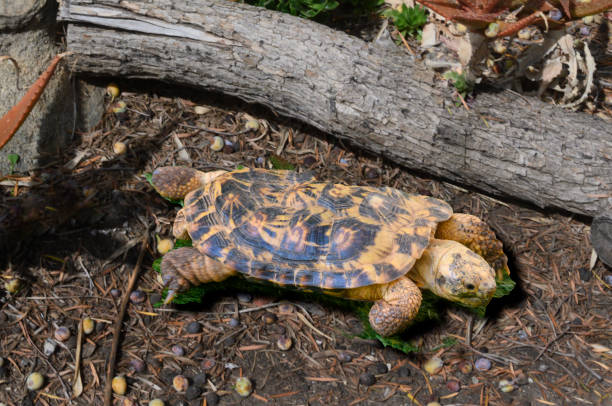ANIMAL: Pancake Tortoise Malacochersus tornieri Type of Animal: Tortoise Habitat: Rocky areas(especially those w/ rocky outcroppings known as kopjes) in scrubland, scrub brush, savanna, semi-desert, Acacia-Commiphora bushland, & Brachystegia woodland, found from 100-6,000 ft above sea level Location(s): Native to S Kenya & N & E Tanzania, introduced population in Zimbabwe Appearance: Named for thin flat flexible shell, brown top shell (carapace) w/ variable pattern of radiating dark lines, bottom shell (plastron) pale yellow w/ dark brown seams & light yellow rays, head, limbs, & tail yellow-brown, males have longer thicker tails, males have darker patterns on carapace, juveniles pale yellow more domed carapace w/ black seams & light yellow rays Food/Diet: Grasses, fruit, greens, flowers, leaves, vegetables, succulents (especially aloe), seeds, weeds, legumes, berries, melons Status in Wild: Critically Endangered Conservation: Breeding from zoos, wildlife parks, & breeding centers. Ban on importing wild-caught animals. Lifestyle: Found in groups of up to 10 individuals Additional Info: Called: Male Female Young-Hatchling Group-Colony Weight: Male-12 oz Female-15-16 oz Young-1.6 oz Gestation: 4-6 months Life Span: 25 years Height: Male-1 in Female-1.5 in Body Length: Male-6 in Female-7 in Young-1.67 in Tail Length: Male-2 in Female-1 in Main predators are mongooses, wild dogs, hyenas, feral/domestic dogs, leopards, lions, badgers, servals, & caracals. Male competition helps w/ breeding success. Lighter flexible shell doesn’t provide much protection, so often found lodged among rocks & crevices. Usually only emerge from shelter for an hour at a time, mainly being active in morning, late afternoon, & early evening. Breeds in January & February in wild, w/ females laying 1-2 eggs per clutch & she releases up to 4 eggs a season. Highly endangered due to pet trade, habitat destruction, conversion to agricultural land, & overgrazing by livestock. Due to dry climate, they get most moisture from food they eat. In their rocky areas, lizards often share homes w/ the tortoises. Tends to have low reproductive rate-another reason they’re highly endangered. Fun Fact(s): When it gets very hot, they will estivate (hibernation during hot weather). When threatened, it will run to a crevice & use legs to lodge itself as deeply inside as possible to prevent predator from getting it out. One of fastest tortoises in world, running as fast as a kilometer an hour.

